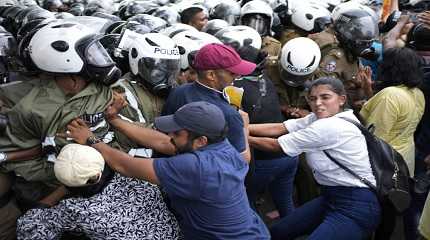
WARSAW, Poland (AP) — Poland’s state broadcasting authority has received multiple complaints over the way state media covered a huge anti-government protest over the weekend, an official said Tuesday.
State broadcaster TVP played down the size and significance of the protest led by the main opposition leader, Donald Tusk. Hundreds of thousands of people demonstrated in Warsaw, making it possibly the largest demonstration in decades in Poland.
Organizers estimated that 500,000 people took part. The number is impossible to verify but the march stretched for kilometers through the streets of Warsaw along the main route and down side streets. Protests were also held in other Polish cities.
TVP, which has long vilified Tusk in its reports, said there were no more than 150,000 people.
Unlike independent broadcasters, TVP didn’t show the march live. At one point, however, it did offer viewers live coverage of the National Parade of the Circles of Rural Areas’ Housewives.
It referred to the peaceful and orderly demonstration as a “march of hate” because of some isolated vulgarities chanted against the government.
Andrzej Krajewski, secretary for the independent Society of Journalists, said that his group considered TVP’s coverage “scandalous.”
The spokeswoman for the National Broadcasting Council, Teresa Brykczynska, told The Associated Press in an email that the council had received 12 complaints alleging “a lack of pluralism, of objectivity, violation of media law, lack of live coverage of the march and (complaining) over the content of news tickers.”
The council, also controlled by the governing Law and Justice party, would analyze the complaints, Brykczynska said.
Law and Justice has for years been using state media, especially TVP, as a mouthpiece.
The march was held on the anniversary of a crucial moment in Poland’s history, the partly free election on June 4, 1989, which paved the way for the end of communist rule. It was held months before an autumn election in which the conservative Law and Justice is fighting for a third term.
The party’s control of taxpayer funded media was among the many issues that people singled out while protesting at the march, which was held in support of democracy and in opposition to the policies of the government.
In another incident reported by Polish media, a TVP reporter on the spot covered up his station’s logo on his microphone with his hand while interviewing participants, hiding his broadcaster’s identity. When he went on air, the logo was visible.
An image posted by a TVP reporter was framed to suggest there were very few people at the march.
These reactions reminded older Poles of how the communist authorities used the same technique to falsely minimize the appearance of huge crowds for the Polish pope, St. John Paul II. The pontiff made historic visits in 1979 and the 1980s to his homeland that inspired mass resistance to the communist government.
Asked about a lack of live coverage of the march, government spokesman Piotr Mueller argued that “there is no obligation in Poland to report every march of Civic Platform,” the main opposition party which led the demonstration.
Another TVP reporter tweeted that the majority of people he talked to said they had come to Warsaw to see the zoo, the National Stadium or eat cotton candy in good weather, an observation whose absurdity triggered mockery and jokes online.
Political observers have argued that the large turnout points to growing opposition to the government as the fall election draws close.
Law and Justice has led opinion polls since it won power in 2015, but has seen growing opposition to its policies. Some argue that the minimization of the march’s significance may come from a realization that the party will have serious competition in the fall election.
Commentator Andrzej Stankiewicz wrote on the Onet news portal that the march showed that for the first time since it took power, Law and Justice leader Jaroslaw Kaczynski “has someone he can lose to.”




